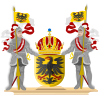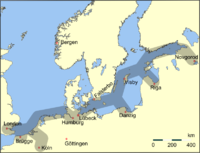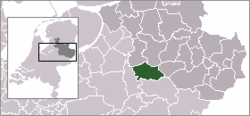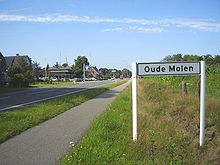- Deventer
-
Deventer — Municipality — Deventer skyline, showing the Lebuinus Church 
Flag
Coat of armsLocation of Deventer in Overijssel, Netherlands Country Netherlands Province Overijssel Area(2006) – Total 134.37 km2 (51.9 sq mi) – Land 131.31 km2 (50.7 sq mi) – Water 3.07 km2 (1.2 sq mi) Population (1 January 2007) – Total 96,596 – Density 736/km2 (1,906.2/sq mi) Source: CBS, Statline. Time zone CET (UTC+1) – Summer (DST) CEST (UTC+2)  Deventer is a municipality and city in the Salland region of the Dutch province of Overijssel. Deventer is largely situated on the east bank of the river IJssel, but also has a small part of its territory on the west bank. In 2005 the municipality of Bathmen (pop. 5,000) was merged with Deventer as part of a national effort to reduce bureaucracy in the country.
Deventer is a municipality and city in the Salland region of the Dutch province of Overijssel. Deventer is largely situated on the east bank of the river IJssel, but also has a small part of its territory on the west bank. In 2005 the municipality of Bathmen (pop. 5,000) was merged with Deventer as part of a national effort to reduce bureaucracy in the country.Contents
Population centres
Associated hamlets at second level
- Deventer (see below)
- Snippeling (a small community about 2 km east of the city centre)
- Colmschate (Deventer suburb quarters surrounding eponymous village 4 km east of the city centre, ice skating hall, small railway station)
- De Bannink
- Oxe
- Diepenveen, a picturesque village 4 km to the north, surrounded by forests
- Molenbelt
- Rande
- Tjoene
- Lettele, in a forest area
- Linde
- Oude Molen ('old mill')
- Zandbelt
- Okkenbroek
- Schalkhaar (former centre of Diepenveen municipality including Lettele and Okkenbroek until 1/1/1999)
- Averlo
- Frieswijk
- Bathmen (independent municipality until 1/1/2005)
- Apenhuizen ('monkey houses')
- Dortherhoek
- Loo
- Pieriksmars
- Zuidloo
History
Foundation and development in the Middle Ages
Deventer was probably founded around 768 by the English missionary Lebuinus, who built a wooden church on the right bank of the river IJssel. This was not the first human settlement at the location; from the Bronze Age to about 400 AD, there was a settlement at Colmschate, 4 km east of the city centre. Remains of this settlement were excavated between 1981 and 2006.
The village of Deventer, already important because of a trading road crossing the river IJssel, was looted and burnt down by the Vikings in 882. It was immediately rebuilt and fortified with an earthen wall (in the street Stenen Wal remains of this wall have been excavated and restored).
Deventer received city rights in 956, after which fortifications were built or replaced by stone walls around the city for defense. Between 1000 and 1500, Deventer grew to be a flourishing trade city because of its harbour on the river IJssel, which was capable of accommodating large ships. The city was a member of the Hanseatic League.
One of the commodities it traded in, dried haddock and cod from Norway, gave the citizens the nickname they carry to this day: "Deventer Stokvis" In the 15th century, Deventer had a common mint, where coins for the three IJssel cities Deventer, Zwolle, and Kampen were made.
Deventer is the place of birth of Geert Groote and home to his Brethren of the Common Life, a school of religious thought that was of great influence on Thomas a Kempis and Erasmus in later times. Together with Haarlem it was among the first cities to have printing presses, dating back to as early as 1477. From around 1300, it also housed a Latin School, which became internationally renowned, and remained in service in changing forms until 1971. Its most famous pupil was the scholar Desiderius Erasmus, who was born in 1466 and attended the school from 1475 to 1484.
16th–20th century
Between 1500 and 1800, the mass of water flowing through the IJssel decreased, decreasing the importance of Deventer's harbour. The competition with trade centres in Holland, as well as the religious war between 1568 and 1648, brought a decline in the city's economy.
In the 18th century, the iron industry came to Deventer. East of the town, so-called "oer", riversand containing iron, was found as early as 900. From this material, ore was produced and brought to town. The main road of the villages Okkenbroek, Lettele and Schalkhaar is still named Oerdijk (Ore Dyke).
In the 19th century, Deventer became an industrial town. Bicycles (Burgers), carpets (Koninklijke Deventer Tapijtfabriek) , tins and cans for food and drinks (Thomassen & Drijver), cigars (Horst & Maas en Bijdendijk & Ten Hove), foundry and heavy machinery (Nering Bögel), and textiles (Ankersmit) were produced until the mid to late 20th century. Some of these industries are still thriving today, such as beds and accessories (Auping) and publishing (Wolters-Kluwer, now with headquarters in Amsterdam)
World War II
Deventer has seen few military engagements throughout its long history, although it was a garrison city of the Dutch cavalry. The industrial area and harbour were bombed heavily during World War II. The city centre has been largely spared, thus offering a view that has remained largely unchanged for the past few centuries.
The female Jewish poet and writer Etty Hillesum lived in Deventer during the war before being deported to Auschwitz.
In Schalkhaar, a village only 2 km northeast of the city centre, barracks were used by the German occupying forces to train Nazi policemen. The compound is now a centre for asylum seekers.
Deventer has been somewhat popular with the film industry. During the production of the movie A Bridge Too Far all of the scenes taking place in nearby Arnhem were filmed in Deventer - as Arnhem itself had lost its historic center.
Modern Times
The city's trade and industry is still of some importance. The city is host to a factory producing central heating systems, and still has offices of editor and publisher Wolters-Kluwer, which is a major player in international scientific and legal publishing.
The Deventer honey cake (Bussink Deventer Koek), produced in Deventer for over 500 years, is still manufactured locally and sold all over the Netherlands and beyond.
Culture
Sights
- The Waag (Weighing-house) on the edge of the Brink square, built in 1550 and restored in 2003. The Deventer City Museum is housed inside the Waag. The Museum's collections include industrial and trading history, paintings by Gerard Terborch and Han van Meegeren, silver objects, and prehistoric findings). Thea Beckman's novel Het wonder van Frieswijck ("The Frieswijck Miracle") features the Waag.
- On the outer wall of the Waag hangs a large kettle that is over 500 years old, said to have been used for a public execution in the late Middle Ages; a man who had produced counterfeit coins was cooked to death in it. According to local tradition,There are holes in the kettle shot by footmen of Napoleon's army around 1809.
- The Lebuïnuskerk (St. Lebuin's Church) in Gothic style, with remarkable ceiling paintings and a beautiful organ. Its tower can be climbed in summer.
- The Brink (market square) with houses, shops, and cafes dating from 1575-1900. The market square is also the center of Deventer nightlife. Alongside this square there is the Bussink "Koekhuisje", where you can buy the famous Deventer Koek (honey-cake). Markets take place every Friday (including a very big one on Good Friday, following a medieval tradition) and Saturday.
- The Speelgoedmuseum (Toy Museum) behind the Waag, housed in one of the most picturesque old houses of the city.
- The medieval Bergkerk (Mountain Church), on top of a small hill (old river dune), now a museum for modern art.
- The picturesque and old streets around the Bergkerk, known as Bergkwartier (Mountain Quarter) situated on and around an old river dune.
- Football stadium De Adelaarshorst, home venue of Go Ahead Eagles situated in a typical 1930s neighbourhood and one of the oldest stadiums still in use today.
Events and festivals
The city hosts three events of national and even international fame:
- In the first week-end of July, the city centre is the scene of the spectacular open air festival "Deventer op stelten" (Deventer on Stilts). Actors and artists give free performances in the streets and on the Brink square. All actors must use stilts during their acts.
- In August, Deventer is home to Europe's largest book fair, attracting some 125,000 visitors.
- The Dickens Festival in December sees some of the oldest streets and alleys in the city dressed up in the style of the Victorian era, as per Dickens' writings. The latter attracted 135,000 visitors in 2004 and 2006.
Transport
Deventer has 2 railway stations - for destinations see
Notable people associated with Deventer
- Gerard Ter Borch
- Jan Bultman
- Ron Dekker
- Desiderius Erasmus
- Geert Groote
- Alexander Hegius
- Etty Hillesum
- Han Hollander
- Guusje Ter Horst
- Jomanda
- Bert van Marwijk
- Han van Meegeren
- Marc Overmars
- Saint Radboud
- Jacobus Revius
- Rutger Jan Schimmelpenninck
- Victor Sikora
- Samuel Holland
- Marthinus Theunis Steyn
- Jan Pieterszoon Sweelinck
- Gertjan Verbeek
- Arjen Grolleman
Johannes Auping
International relations
See also: List of twin towns and sister cities in The NetherlandsTwin towns — Sister cities
Deventer is twinned with:
 Tartu, Estonia [1]
Tartu, Estonia [1] London, Ontario, Canada [1]
London, Ontario, Canada [1]
 Sibiu, Romania, since 2009.
Sibiu, Romania, since 2009.
Notes
- ^ a b "Twin Cities of Tartu". ©2007 City of Tartu. http://tartu.ee/?lang_id=2&menu_id=13&page_id=1096. Retrieved 2009-01-04.
External links
Members of the Hanseatic League by Quarter Wendish Quarter Anklam · Demmin · Greifswald · Hamburg · Kolberg (Kołobrzeg) · Lüneburg · Rostock · Rügenwalde (Darłowo) · Stettin (Szczecin) · Stolp (Słupsk) · Stockholm · Stralsund · Visby · Wismar
Saxon Quarter Baltic Quarter Westphalian
QuarterPrincipal Kontore Subsidiary Kontore Other cities  Municipalities of Overijssel
Municipalities of OverijsselAlmelo · Borne · Dalfsen · Deventer · Dinkelland · Enschede · Haaksbergen · Hardenberg · Hellendoorn · Hengelo · Hof van Twente · Kampen · Losser · Oldenzaal · Olst-Wijhe · Ommen · Raalte · Rijssen-Holten · Staphorst · Steenwijkerland · Tubbergen · Twenterand · Wierden · Zwartewaterland · Zwolle
 Categories:
Categories:- Cities in the Netherlands
- Members of the Hanseatic League
- Municipalities of Overijssel
- Populated places in Overijssel
- Salland
- Deventer (see below)
Wikimedia Foundation. 2010.







